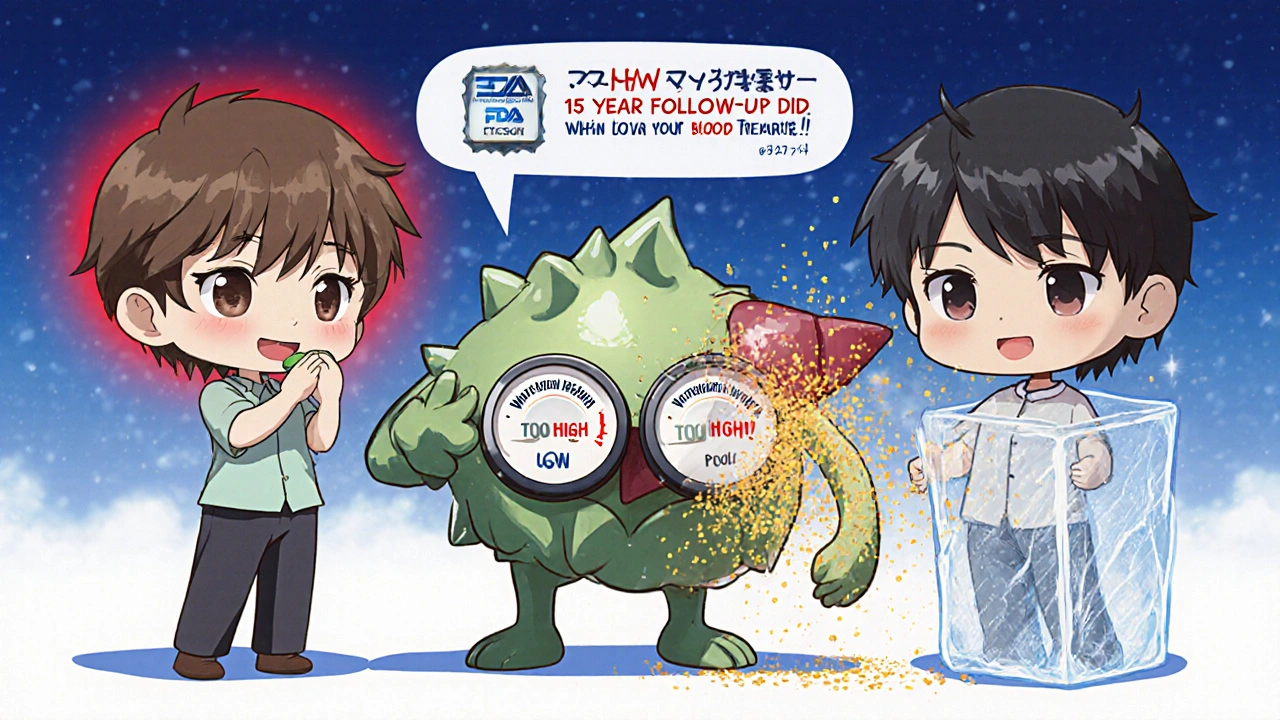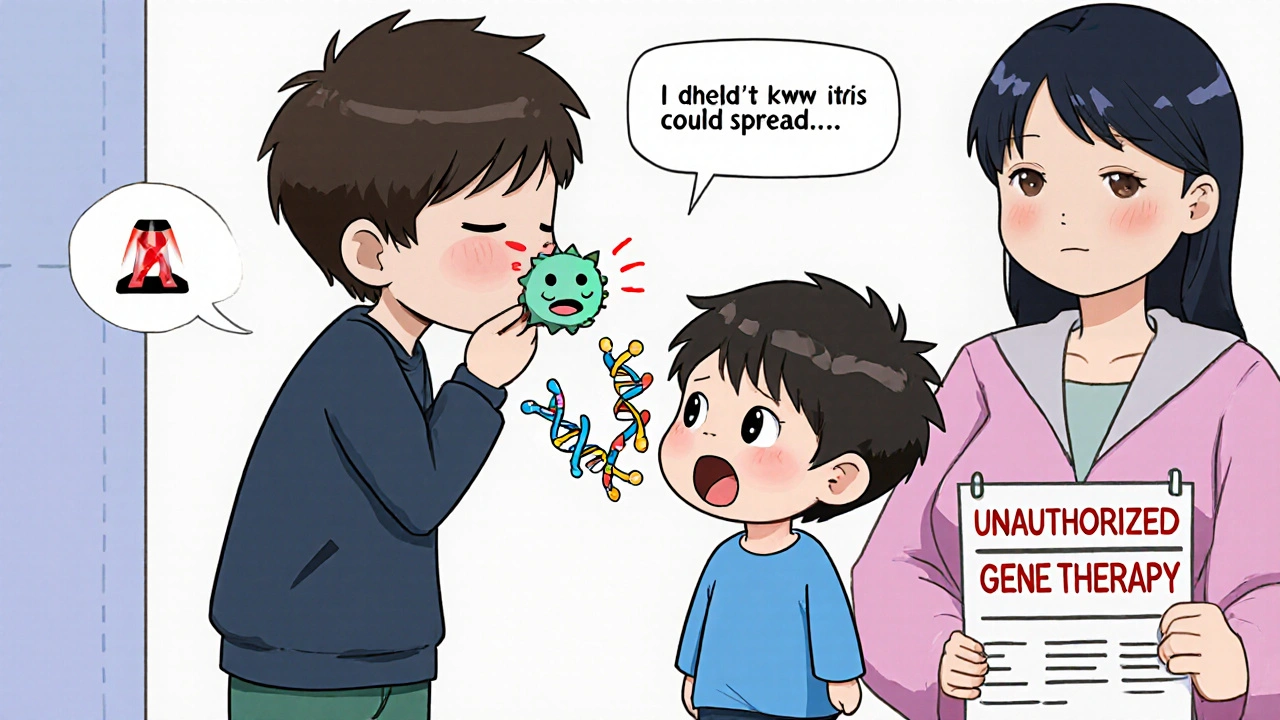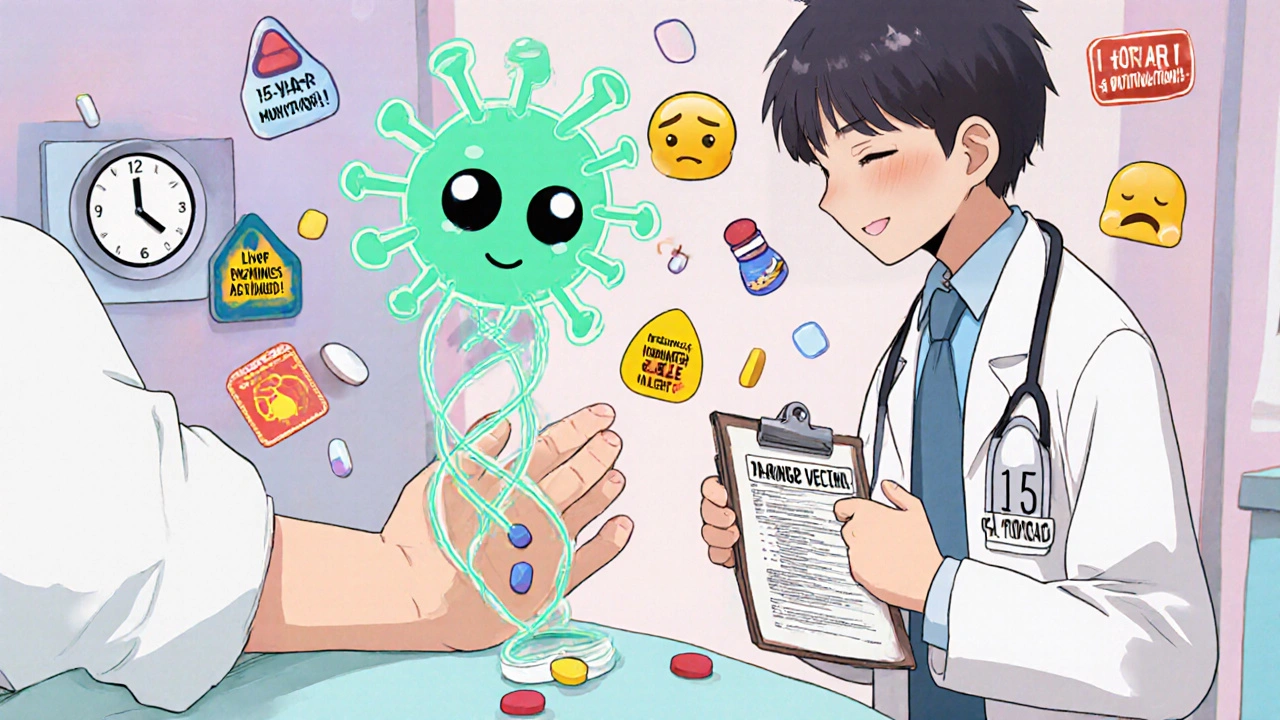Gene Therapy and Drug Interactions: Unique Safety Challenges
31 Oct, 2025Gene therapy promises to fix diseases at their root-by rewriting faulty genes inside your cells. But behind this breakthrough is a hidden danger: how these treatments interact with everyday medications. Unlike pills or injections, gene therapies don’t just wear off. They can change your biology permanently. And when they do, they can mess with how your body handles drugs you’ve been taking for years. This isn’t science fiction. It’s happening now, and the risks are real.
Why Gene Therapy Isn’t Like Regular Medicine
Most drugs work by blocking or boosting something in your body-like lowering blood pressure or killing bacteria. Gene therapy does something completely different. It delivers new genetic instructions into your cells using viruses that have been stripped of their ability to cause disease. These modified viruses, called vectors, sneak into your cells and drop in a corrected gene. Once inside, your cells start producing a protein they were never able to make before. That sounds amazing. But here’s the catch: your body doesn’t know the virus is harmless. It sees it as an invader. And that triggers a powerful immune reaction. In 1999, an 18-year-old named Jesse Gelsinger died after receiving gene therapy for a rare liver disorder. His immune system went into overdrive, causing multiple organ failure. The virus used in his treatment had been tested in monkeys, and two of them died too. But the warning was ignored. That tragedy changed everything. Now, regulators require long-term monitoring for gene therapies. Not 30 days. Not six months. For some treatments, patients must be followed for 15 years. Why? Because the changes gene therapy makes can lie dormant for years before causing harm.When Your Genes Start Interfering With Your Pills
Imagine you’re on a blood thinner like warfarin. Your doctor has carefully adjusted your dose so your blood doesn’t clot too much or too little. Now, you get gene therapy to treat a genetic disorder. The viral vector used in the treatment triggers inflammation. That inflammation can turn up or turn down the enzymes in your liver that break down warfarin. Suddenly, your drug levels are off. You could bleed internally-or develop a clot. This isn’t theoretical. Viral vectors activate the immune system in ways that directly affect cytochrome P450 enzymes. These enzymes handle about 75% of all prescription drugs. When they’re switched on or off by gene therapy, drug levels become unpredictable. There’s no test to tell you how your body will react. It depends on your genes, your immune history, even your age. And it’s not just liver enzymes. Gene therapies can alter how your kidneys filter drugs, how your gut absorbs them, or how proteins in your blood bind to them. One patient might need half their usual dose of a painkiller after gene therapy. Another might need double. There’s no rulebook for this yet.Off-Target Effects and Hidden Risks
Gene therapy isn’t always precise. The viral vectors don’t always go only to the target cells. They can end up in your heart, your brain, your muscles-even your sperm or egg cells. That’s a problem if the therapy accidentally turns on a cancer-causing gene. Between 1999 and 2002, five children in gene therapy trials for a rare immune disorder developed leukemia. The therapy had inserted the new gene right next to a gene called LMO2, which controls cell growth. The result? Uncontrolled cell division. One child died. Today, safer vectors like AAV (adeno-associated virus) are used more often. But AAV isn’t perfect. Different AAV types target different tissues. Some go to the liver. Others go to the eyes or muscles. If you’re on a drug that’s metabolized by the liver, and your gene therapy targets the liver, you’re at higher risk of interaction. If you’re on a drug that affects the nervous system, and the therapy accidentally reaches brain cells, you could get unexpected side effects. Even scarier: what if the therapy changes your liver cells so they start producing a protein that alters how other drugs are processed? Or what if the therapy causes your immune system to attack your own liver over time? These are long-term risks that don’t show up in clinical trials lasting two years. They show up five, ten, or fifteen years later.
Transmission Risk: Therapy in Your Family
Here’s something most people don’t realize: some gene therapies can spread. Not like a cold. But through bodily fluids-saliva, blood, semen. If you receive a gene therapy using a viral vector, there’s a chance you could pass the modified virus to someone else. The FDA now requires companies to prove their therapies won’t transmit. But proving that is hard. And what if it happens anyway? Imagine your spouse gets infected with the same viral vector you received. They never signed a consent form. They never had a medical evaluation. They’re now receiving a gene therapy they didn’t ask for. Their immune system might react violently. Their liver might shut down. Their child could be born with altered DNA. This isn’t science fiction. It’s a documented concern in regulatory guidelines.Who’s at Risk? And Who’s Being Left Behind?
Right now, gene therapies are mostly tested on adults with rare diseases. But what about children? Elderly patients? People with multiple chronic conditions? Someone on 10 different medications? We don’t know how gene therapy will interact with their drug regimens. Clinical trials exclude these patients because they’re too complex. But they’re the ones who need these therapies the most. Genetic differences between people make prediction nearly impossible. Two patients with the same disease might respond to the same gene therapy in completely different ways. One might have a strong immune reaction. The other might not. One might metabolize drugs faster after treatment. The other slower. We don’t have tools to measure this in advance.
What’s Being Done? And What’s Missing?
Regulators like the FDA know the risks. They require 15-year follow-ups. They demand detailed data on vector behavior. But there’s no database tracking which gene therapies interact with which drugs. No clinical guidelines telling doctors to hold off on statins or anticoagulants after gene therapy. No standardized blood tests to monitor for changes in drug metabolism. What’s needed? Long-term studies tracking thousands of patients on multiple medications before and after gene therapy. Real-time monitoring of liver enzymes, immune markers, and drug levels. Genetic screening to identify who’s at higher risk of immune reactions. And most of all-transparency. Patients need to know: if you get this therapy, your entire medication list might need a complete rewrite.What Should Patients and Doctors Do Now?
If you’re considering gene therapy:- Make a full list of every medication, supplement, and over-the-counter drug you take.
- Ask your doctor: Has this therapy been tested with any of these drugs?
- Find out if your treatment uses an integrating vector (like older retroviruses) or a non-integrating one (like AAV).
- Ask about long-term monitoring plans. Will you need blood tests every 6 months for 15 years?
- Inform all your healthcare providers-including your dentist and pharmacist-that you’ve had gene therapy.
The Future Is Here-But We’re Not Ready
Gene therapy is no longer experimental. It’s approved for spinal muscular atrophy, certain inherited blindness, and sickle cell disease. More are coming. But our drug safety systems were built for pills that last hours or days. Gene therapy lasts decades. The interactions aren’t just possible-they’re inevitable. We’re learning as we go. And the cost of mistakes is measured in lives. The science is brilliant. But the safety infrastructure? It’s still catching up. Until we have better data, better monitoring, and better guidelines, every gene therapy patient is part of an uncontrolled experiment. The hope is real. The risk is real too. And until we treat both with equal seriousness, we’re gambling with lives that could have been saved.Can gene therapy cause cancer years after treatment?
Yes. In early gene therapy trials for severe combined immunodeficiency (SCID), five children developed leukemia because the therapeutic gene inserted itself next to a cancer-promoting gene called LMO2. This is called insertional mutagenesis. Modern therapies use safer vectors like AAV, which rarely integrate into the genome, but long-term monitoring is still required. The FDA mandates up to 15 years of follow-up for therapies with integration risk.
Do I need to stop my medications before gene therapy?
It depends. Some drugs, especially those that suppress the immune system, may be paused before treatment to reduce interference with the viral vector. Others, like blood thinners or diabetes meds, may need dose adjustments after therapy because gene therapy can change how your liver metabolizes drugs. Always consult your treatment team-never stop or change medications on your own.
How long do I need to be monitored after gene therapy?
For gene therapies using vectors that can integrate into your DNA or establish long-term infections (like some herpesvirus-based systems), the FDA requires 15 years of follow-up. This includes regular blood tests, imaging, and assessments for cancer, immune reactions, or organ damage. Even if you feel fine, skipping these checkups could mean missing a delayed side effect.
Can gene therapy affect my ability to take over-the-counter drugs or supplements?
Absolutely. Supplements like St. John’s Wort, fish oil, or high-dose vitamin E can affect liver enzymes and blood clotting. After gene therapy, even common OTC painkillers like ibuprofen or acetaminophen may behave differently in your body. Always disclose all supplements to your care team-what seems harmless could trigger a dangerous interaction.
Is gene therapy safe if I’m on multiple medications for chronic conditions?
Most gene therapy trials exclude patients on multiple medications because interactions are too complex to predict. If you have conditions like diabetes, heart disease, or kidney failure, your eligibility depends on the specific therapy and your overall health. Talk to your doctor about whether your drug regimen makes gene therapy too risky-or whether your condition might improve enough to reduce your medications long-term.

Jim Peddle
November 1, 2025 AT 20:23Let’s be real - this isn’t medicine. It’s genetic roulette with a side of corporate liability waivers. They’re injecting modified viruses into people and calling it a cure while ignoring that we’re essentially turning patients into walking bioweapon delivery systems. The FDA’s 15-year monitoring? That’s not safety - it’s damage control with a spreadsheet. And don’t get me started on the fact that these therapies can spread through bodily fluids. Someone’s spouse is going to wake up with altered DNA and no consent form. This isn’t science. It’s a biohacking cult with FDA approval.
They banned gene therapy after Jesse Gelsinger died. Then they brought it back with shinier vectors and the same arrogance. The only thing that’s changed is the price tag - now it’s $2M per dose instead of $200K. The real question isn’t whether it works - it’s who’s paying for the corpses.
S Love
November 1, 2025 AT 23:32Thank you for this exceptionally well-researched and sobering piece. The nuances you’ve outlined - particularly regarding cytochrome P450 modulation and insertional mutagenesis - are precisely the kind of detail that gets lost in the hype cycle surrounding gene therapy. It’s not enough to say ‘it’s revolutionary’; we must also acknowledge that revolutionary doesn’t mean safe, and permanent doesn’t mean predictable.
Doctors treating patients post-therapy need to adopt a new mindset: no longer can we assume pharmacokinetics are static. Every prescription, every OTC supplement, every herbal remedy must be re-evaluated as if the patient’s biochemistry has been rewritten. This isn’t just clinical caution - it’s a paradigm shift in medical practice.
And yes, the 15-year follow-up isn’t excessive; it’s the bare minimum. If we’re altering human biology at the genetic level, we owe every patient longitudinal accountability. Anything less is negligence dressed in innovation.
Pritesh Mehta
November 3, 2025 AT 10:16Look, the West has been obsessed with technological superiority for decades - but this gene therapy frenzy is not progress, it’s a symptom of a civilization that has lost its moral compass. We don’t need to edit genes to cure disease; we need to fix the food, the water, the pollution, the stress, the greed that created these diseases in the first place. Why are we chasing biological Band-Aids when the foundation is crumbling?
And let’s not pretend this is about healing. It’s about control. Corporations patenting human DNA sequences. Governments using gene therapy as a tool for population management. The fact that you’re being told to ‘monitor for 15 years’ is not a safety protocol - it’s a surveillance contract. You’re not a patient. You’re a data point in a biotech experiment funded by venture capital and shielded by patents.
India understands this. We don’t rush into genetic manipulation. We respect the body’s natural balance. We don’t turn medicine into a corporate religion. The West thinks it’s advanced - but it’s just addicted to its own arrogance.
And yes, I’ve seen the data. The viral vectors don’t just target liver cells. They migrate. They linger. They whisper to your genome long after the ‘treatment’ is over. And when your child is born with a mutation you didn’t consent to - don’t blame the science. Blame the hubris.
Billy Tiger
November 4, 2025 AT 02:56Katie Ring
November 5, 2025 AT 09:49It’s terrifying how little we understand about what we’re doing - and even more terrifying how little we care. We’re treating gene therapy like a software update when it’s actually rewriting the operating system of a human being. We don’t test for downstream effects on metabolism, immunity, or intergenerational risk because it’s expensive and inconvenient. We’d rather gamble with lives than delay profit.
And the worst part? The people most vulnerable - the elderly, the chronically ill, the poor - are the ones excluded from trials. They’re told they’re ‘too complex.’ But when the therapy fails five years later, when their kidneys start failing from a drug interaction they never knew to watch for, they’ll be the ones left with no safety net. This isn’t progress. It’s structural violence disguised as hope.
We need to stop celebrating the miracle and start demanding the margins of error. Because the margin here isn’t 1%. It’s 100% - and we’re all in it.
Adarsha Foundation
November 7, 2025 AT 01:52I appreciate the depth of this post and the courage it takes to speak honestly about the risks. I come from a culture where healing is often seen as a harmony between body, environment, and time - not a technical fix. Gene therapy is fascinating, yes, but we must not forget that biology is not a machine to be programmed. It’s a living, evolving system.
Perhaps instead of rushing to edit genes, we should invest equally in understanding why these mutations occur in the first place - in diet, in stress, in pollution, in inequality. And for those who do receive therapy - let us offer not just 15 years of monitoring, but 15 years of compassion, community, and support. Let’s not turn patients into data points.
Transparency is not optional. Consent must be truly informed. And if there’s even a chance this therapy can pass to loved ones without their knowledge - then we have a moral duty to pause, reflect, and redesign.
We can be both hopeful and humble. We don’t have to choose between science and ethics. We must hold both.
Alex Sherman
November 8, 2025 AT 21:52People don’t understand that gene therapy isn’t just risky - it’s morally irresponsible. You’re tampering with the blueprint of life and calling it medicine. Who gave anyone the right to alter human DNA for profit? The FDA doesn’t protect you - they license it. The doctors don’t warn you - they upsell it. And the patients? They’re too desperate to say no.
And now we’re supposed to believe that ‘AAV vectors are safer’? That’s like saying a loaded gun is safer because it has a safety switch. The risk isn’t gone - it’s just buried deeper. And when it explodes - in a child’s liver, in a spouse’s blood, in a grandchild’s genome - you’ll be told it was ‘an unforeseen complication.’
This isn’t science. It’s bioethics bankruptcy.
And if you’re one of those people saying ‘it’s saving lives’ - ask yourself: whose lives? And at what cost to the rest of us?
Oliver Myers
November 10, 2025 AT 04:40Thank you for writing this - truly. I’ve been following gene therapy for years, and this is the most balanced, clear-eyed take I’ve seen. It’s easy to get swept up in the hype - ‘cure for sickle cell!’ ‘vision restored!’ - but you’ve laid out the quiet, creeping dangers that no one talks about at the dinner table or in the waiting room.
I’m a pharmacist, and I’ve already started asking every patient who’s had gene therapy: ‘What meds are you on? What supplements? Have you told your dentist?’ It’s not just about avoiding interactions - it’s about building a new kind of trust. We’re not just treating a disease anymore. We’re managing a lifelong biological shift.
And yes - even ibuprofen. Even fish oil. Even that ‘harmless’ herbal tea. Everything changes. I’ve had patients come in with normal lab values… and then their warfarin level spikes out of nowhere. No new pills. No new foods. Just… time. And a gene therapy from two years ago.
We need a registry. We need guidelines. We need doctors to stop treating this like a one-time fix. It’s not. It’s a new normal. And we owe every patient the tools to live in it safely.
You’ve given us the language to talk about this. Thank you.